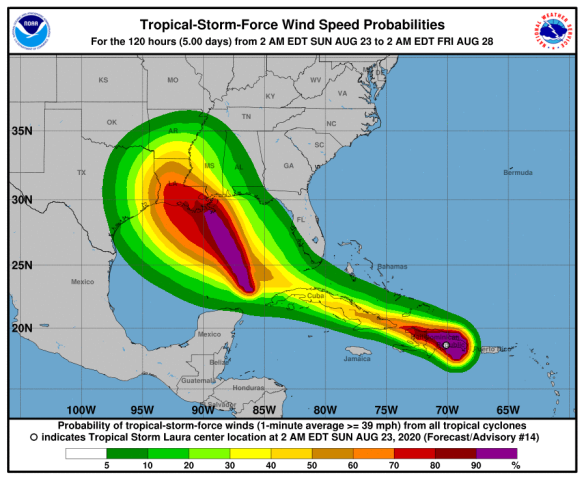




Hurricane Laura pummeled the Gulf Coast on Thursday morning with maximum sustained winds of 120 mph and storm surge waters, exceeding 9 feet in some parts of Louisiana.
Laura slightly weakened from a Category 4 storm with 150 mph winds to a Category 3 after making landfall around 2 a.m. eastern time, near Cameron, Louisiana. The storm is 30 miles north-northwest of Lake Charles and moving north at 15 mph, the National Hurricane Center said in its 5 a.m. update.

“At the time of landfall, Laura was a ferocious looking hurricane with a clear circular eye, an intense eyewall, and tightly-coiled surrounding spiral bands,” the NHC said.
Laura has “unsurvivable” storm surge, according to the NHC, capable of penetrating 40 miles inland from the Louisiana-Texas coast, as much as 20 feet high in some places. Thus far, most areas around the coast have received surge levels higher than 3 feet, but certain areas have recorded over 9 feet, according to the National Oceanic and Atmospheric Administration’s storm surge map.
Continue reading
Tropical Depression 13 formed in the central tropical Atlantic late Wednesday, and Tropical Depression 14 formed Thursday morning.
Both systems remained tropical depressions Friday morning. However, Tropical Depression 13 has yet to form a cohesive center.
“Today we are in monitor mode. I do not have a call to action, other than we should always have a hurricane kit on hand,” meteorologist Brian Shields said.
We have two atlantic basin tropical storms this week. Predictions are that they will merge at some point near the panhandle of Florida.

To have two tropical systems in the Gulf, potentially making landfall near the same time is unusual and could lead to something that is even more rare – the Fujiwhara effect.
The Fujiwhara effect happens when two tropical systems come near, then orbit each other, or possibly merge into one system.
It is named for Sakuhei Fujiwhara, a Japanese meteorologist who first described the effect in 1921.